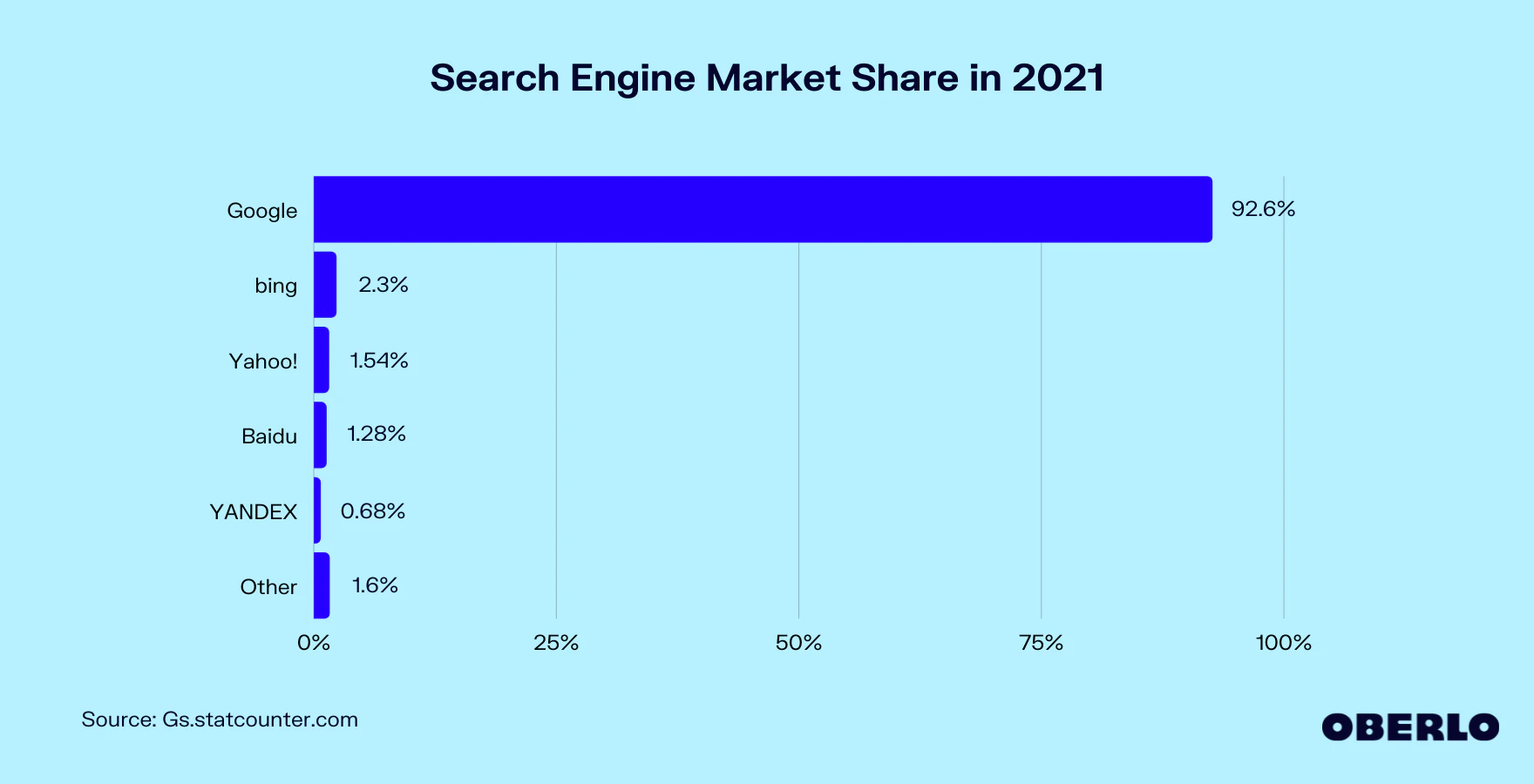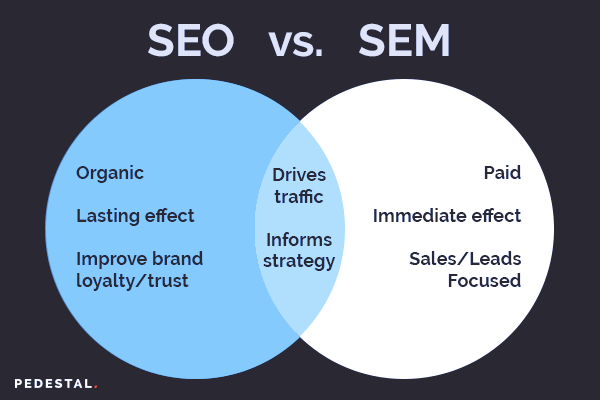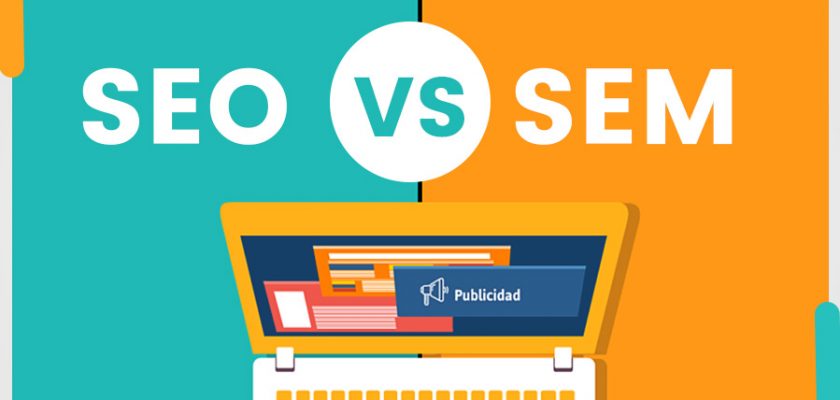SEO and SEM both stand for search engine optimization and search engine marketing, respectively, but they differ in their objectives and the techniques used to achieve them.
The confusion between SEO and SEM has existed for a long time and makes it hard to understand how these two types of campaigns work together to reach your business goals. Plus, it is essential to know that Google currently has 87.76% of the search engine market share. (Statista)

This blog will give you the keys you need to understand SEO vs. SEM and decide which strategy fits your needs best. So, let’s start with some background information on each technique.
Highlights of Contents
What is SEO?
SEO is a search engine optimization strategy designed to tweak website content and boost rankings on significant search engines like Google or Bing.
There are two main aspects of SEO: on-page SEO, which has to do with optimizing your website itself, and off-page SEO, which has to do with building backlinks.
SEO professionals analyze your site’s design, its competitors’ sites, and even what people have typed into the various search engines, all to determine which keywords will lead you to success.
What is SEM?
SEM is short for search engine marketing. Search engine marketing uses online ads to drive customers to your website from Google, Bing, or Yahoo. These ads are called pay-per-click ads or PPCs. The most meaningful advantage of search engine marketing is that it can target a specific audience.
With SEO, you have to get lucky with a ranking that brings in lots of traffic. With PPCs, you have complete control over what people see on their screens when they’re searching online for something like your business type or product offering.
Why is Search Engine Marketing So Powerful?
In many ways, search engine marketing (or SEM) is more powerful than search engine optimization (or SEO). While both are important to online success, a well-executed SEO campaign will help your website rank in organic search results.
A well-planned and executed SEM strategy will allow you to directly target customers searching for products or services like yours with paid ads. These can appear above, below, or beside organic results on Google—allowing you to get exposure to customers who may not have otherwise found your website.
You can also use social media platforms like Facebook and Twitter as an additional means of targeting people who would be interested in your product or service.
Why is Search Engine Optimization So Important?
A well-optimized website is a critical component of any successful business strategy which includes optimizing your SEO (search engine optimization) and increasing your SEM (search engine marketing).
Although they work together, you must learn to understand each practice independently, as they are very different. It’s crucial to stay ahead of SEO trends so that you can better understand how search engines look at websites today.
Ultimately, these practices will create new opportunities for your business and ensure long-term success. Here are some practical reasons you should care about SEO: visibility, sales, leads, and brand development.
Without search engine optimization or SEO, you won’t get any of these benefits; on a local level, you may even lose business to your competitors if they have higher rankings in search results.
As more consumers turn to Google for information (67% of adult Internet users start their product research there), having a high ranking can be crucial for your business’ success.
What Does SEO Offer Over SEM?
Both SEO and SMO are best practices for improving your website’s visibility in search engines.
You can use SEO and SEM on your site, but using one doesn’t negate using another. SEM refers only to paid advertising strategies that drive traffic from organic search results. Combining them may boost your business more than employing just one or another.
- SEO Builds Trust
Good SEO is invaluable for long-term business success. When people search for you, they want to know that they could trust you. The more trustworthy your site’s design and content, the better it will rank in organic search results. Thus, it helps build trust over time.
- SEO Requires Zero Ad Spend
Unlike pay-per-click ads, SEO isn’t about spending a single cent on getting traffic. Search engine optimization strategies center around generating high rankings on Google.
If you start showing up in search results when people search for terms related to your business, you can attract new customers without having to shell out any money for ad placement. That’s an attractive benefit for any small business owner looking to keep costs low.
- SEO Works 24/7
Search engine optimization involves getting your site as high up on search engine results pages (SERPs) as possible. Because it works independently of you (i.e., 24/7), it’s a powerful way to draw in new customers for your business, even when you aren’t marketing directly to them.
Just make sure that you optimize each page on your site so that people can find what they need.
What Does SEM Offer Over SEO?
- SEM Creates an Immediate Impact
Unlike SEO, which helps you rank in search results over time, paid search advertising gives you instant results. Your business can quickly become visible to consumers when they search for something related to your product or service by targeting a specific keyword or phrase.
As such, it’s a potent tool for small businesses looking to make a big splash in a short amount of time.
- SEM Delivers Targeted Ads
Search engine marketing (SEM) helps deliver highly targeted ads to those most likely interested in what you’re selling. While search engine optimization (SEO) can get your website noticed, it doesn’t help you build a sales funnel and customer base.
- SEM Serves as a Cost-Effective Strategy
Search engine marketing (SEM) is a cost-effective marketing strategy because it allows you to reach many people interested in your business effectively. Through pay-per-click (PPC) advertising, organic search results, or social media channels, you can accomplish it.
Depending on your PPC plan, you will be able to get creative with how you advertise your company’s products or services to maximize returns on investment.
What are the Disadvantages of SEO?
- SEO works slowly, and it could be months or years away from seeing tangible results from SEO, whereas you’ll see your investment in an SEM campaign reflected almost immediately.
- The other disadvantage of SEO is that Google is constantly changing its search algorithm. Web admins need to learn new techniques to ensure their sites still show up on Google searches whenever there’s any change.
- With SEM, businesses pay for results; therefore, they don’t have to worry about changes in Google’s algorithm or making updates to their websites.
What are the Disadvantages of SEM?
- SEM has disadvantages. It’s expensive, and it’s not a long-term solution.
- SEM can be more costly than SEO because you have to pay for results.
- It does not provide tangible benefits as SEO does.
- For a company like Facebook, SEM is the most effective tool. It might not be worthwhile for a small business, though, and may only provide short-term benefits.
SEO and SEM: Comparing the Differences & Similarities
In Search Engine Optimization (or SEO), website owners do everything to make their site as easily searchable as possible. Many factors affect how your business appears in search results: title tags, meta descriptions, link popularity, on-page optimization, etc.
Search Engine Marketing (or SEM) is a type of online advertising that allows businesses to pay for ad placement to drive traffic back to their website or landing page from a popular search engine like Google.
Let’s look at the below infographic to comprehend the differences and similarities of SEO and SEM more precisely.

Final Thoughts
There’s a lot of similarity between SEO and SEM as they both deal with getting consumers to your website. It all depends on how you go about it. With SEO, you’re trying to increase your brand awareness, while SEM is a way to increase traffic to your website.
Since SEO is often more focused on building brand awareness, it can take longer to see its effects in increased search engine traffic. SEM is more focused on growing visibility through paid advertising channels such as Google AdWords and Bing Ads.
Most marketing agencies agree that using an integrated approach that combines SEO/SEM strategies is best for business growth over time.
Find the top 100 SEO companies for your website’s ranking and business growth.
Frequently Asked Questions
What is SEM in Digital Marketing?
SEM is a term for digital marketing that involves optimizing ads with keywords for search engines. It encompasses a wide variety of techniques in online marketing. It includes uploading content to blogs and social media platforms, designing infographics, publishing videos on YouTube or embedding them into web pages, and email marketing campaigns.
What are the Two Primary Types of SEM?
Two types of SEM are cost-per-click (CPC) advertising and cost-per-impression (CPM) advertising. Cost-Per-Click Advertising enables businesses to show their ads based on an individual’s search term or keyword.
Cost Per Impression Advertising is a performance-based model where advertisers pay for each ad that appears before the customer without clicking on anything to make it happen.
How is SEO Different from SEM?
SEO and SEM are different parts of online marketing that work together. SEO is a process that improves the “rankings” of a website on Google and other search engines.
SEM stands for search engine marketing. SEM includes natural search results from Google and paid advertisements with keyword links at the top or sides of the page.
